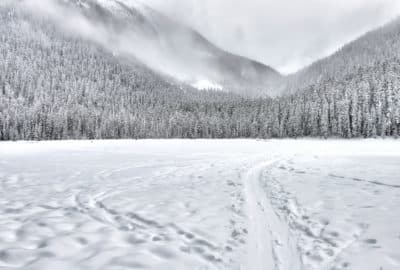Why build a magnetically shielded room?
Wednesday 12th Jan 2022, 12.30pm
One way to delve deep into the ancient history of the Earth – or other planetary bodies for that matter – is to examine the magnetism recorded by rocks. Kind of like a fossilised magnetic fingerprint. But trying to do this in an environment where another magnetic field exists (i.e. everywhere on Earth!) is pretty challenging. Enter the ‘magnetically shielded room’! Join us as we catch up with Prof James Bryson from Oxford’s Department of Earth Sciences, and find out all about this very special DIY project.
Emily Elias: The Earth gives off a natural magnetism, it’s something that we don’t notice but if you’re a researcher trying to study really fine details this can be a bit annoying. So what is a researcher to do but naturally build a room that counters it?
On this episode of The Oxford Sparks Big Questions Podcast we’re asking why build a magnetically shielded room?
Hello, I’m Emily Elias and this is the show where we seek out the brightest minds at the University of Oxford and we ask them the big questions. For this one we’ve found a researcher who has been living his DIY fantasy.
James Bryson: It will be covered in wood eventually, I was talking to the guys who are building it today, we can go in, but only if we stand on that bit of wood and understand that is not nailed down at all.
Emily: Shall we try it?
James: Yes. I’m James Bryson and I’m the associate professor of mineralogy here in the Earth Sciences department.
Emily: Okay, and so you are in the process of building a magnetically shielded room, what is a magnetically shielded room?
James: Right, so when we try and study the ancient history of the Earth or other planetary bodies one way we can do so is by looking at the magnetism that’s recorded by rocks. If we want to do that we’ve got to somehow access their magnetic memories and we want to do that in the magnetically cleanest environment that we can. So we build rooms that shield the Earth’s natural magnetic field which allow us to study our rocks in a lot of detail.
Emily: So what do you mean by that? Why can’t you just use any other room to study rocks in?
James: The Earth’s generating a magnetic field today and it’s everywhere, anywhere you go on Earth you’ll be experiencing it. So if we’re trying to measure a really weak magnetic memory inside a rock we don’t want the Earth’s field there too. So we build these rooms that shield it, the Earth’s field actually gets sucked inside the walls of the rooms. So inside the room there is no background field at all, so we can measure the very weak magnetic signals inside our rocks.
Emily: Wowzer, so how would you use this in your research then?
James: So I study the magnetism of extra-terrestrial rocks, so rocks that have come from space which are known as meteorites. We can learn an awful lot about how the solar system actually formed by looking at the magnetism carried by these rocks. So for instance in the first five million years following the ignition of the sun, our solar system didn’t have any planets in it yet it just had this colossal cloud of dust and gas that stretched for billions of kilometres.
Within that short time period the whole thing collapses down into the planets we recognise today and as they collapse down they form their initial proto planets, that sets in motion their long term evolutionary pathway. So the reason that Earth supports life today and Venus doesn’t was established four and a half billion years ago.
We’re trying to understand what happened in that first 5 to 10 million years that meant that was the case. One way we can do that is by looking at the magnetism of the rocks that date from that period which are the meteorites that are landing on Earth today.
Emily: So this room that you’ve been building, what does it look like?
James: It’s about two meters by two meters by two meters.
Emily: So it’s like garden shed size?
James: Yes, sort of, that kind of size.
Emily: There seems to be some sort of shiny metal on the wall, what is that?
James: Yes so it’s this metal called Mu-metal which is just a really good absorber of magnetic fields. So as we stand inside here all of the Earth’s field that’s coming into the department and into this lab gets sucked into this metal that makes up the walls. That means that instead of it propagating through the room it goes into the metal in the walls, so it goes sort of around the room. It’s just creating like a cavity that has very, very weak magnetic fields inside it.
Emily: So the metal is just kind of strapped to these two by fours, is that a two by four? Yes, I’m not a construction worker.
James: Yes, we’ve got all this framework that we’ve constructed, we nail three layers of metal to it and we overlap them to sort of maximise their shielding effect. It just involves a lot of hard work from the buildings team here nailing it all up, it’s taken a few months to get to this point, but we’re almost there.
Emily: I don’t feel different being inside this metal box, should I feel different?
James: Not really, if you look at birds and turtles they have an active magnetoreception, they know exactly where north is and that’s what helps them migrate. They’ve honed this over millions of years of evolution. There have been some preliminary results a few years ago that suggested that humans have got a hangover in our evolutionary pathway of this magnetoreception. So similar to an appendix it’s sort of left over, we don’t really use it much today.
We might, although we don’t actively feel it, have a passive leftover magnetic reception that would start getting affected if we spent a long time in this room, but I don’t think we’re really going to be feeling- Or, certainly, I don’t feel anything active and as you just said, you don’t either.
Emily: So why is this such a big deal for Oxford to have one of these magnetically shielded rooms? You’ve been around the science block for a while, wouldn’t you already have one of these knocking about?
James: So we’ve got one which has got our sort of workhorse instrument in, which we call the magnetometer, it’s just an instrument which measures the magnetism inside a rock.
We’ve had magnetometers in various forms for 60 or 70 years now and we’re really trying to push the frontiers of what we can understand. If we’re going to do that we need to come up with the next generation of instrument. So we’re building a new magnetically shielded room to house our new instrument that’s going to be arriving in January called the quantum diamond microscope. Which is capable of measuring magnetic memories on extremely small length scales and at high resolution.
So if you ever looked at the sand on a beach, sometimes if you take sand and you move it down a river or move it through the ocean you’re going to end up building sedimentary rocks which is where each of those sediments gets compacted and forms a rock. If we wanted to study the magnetism recorded in each individual sediment or grain of sand or anything like that, that’s just too small and too weak to measure using the instruments we’ve had for the last 60 or 70 years. We need the next generation and that’s what we’re going to be putting inside this shielded room.
Emily: You’re not going to put sand inside this shielded room are you? You’re going to out something a little bit cooler.
James: One of the types of meteorites that I study we can think of as like a cosmic sedimentary rock. So there were a whole bunch of processes that occurred in the very early solar system that created the first rocks in the solar system. These were happening as soon as the sun ignited, in fact the ignition of the sun triggered some of the formation of these materials. They are sort of millimetre sized and they’re free floating throughout our protoplanetary disc, this big cloud that existed before the planets did. Under gravity these can start collapsing to form the first planetary bodies that were up to about 100 km large.
What I’m going to be doing is taking the meteorites that come from those bodies and extracting the individual cosmic sediments from them and measuring each one of them individually to try and build up a complete picture of the magnetism of the early solar system.
Emily: Where did you get this meteorite from?
James: So we have a bunch of meteorites, but a lot of them come from museums and we’re very fortunate to have an amazing collection here in the UK. I work with the guys in the Natural History Museum a lot and the Natural History Museum here in Oxford.
I’ve also been involved in this project looking at a meteorite that fell in the UK in February 2021, the Winchcombe meteorite, which is this incredibly rare opportunity for the UK science community where- or the meteoritics community within the UK. We’ve all come together to sort of systematically study this rock in as much detail as we can using the breadth of expertise that we have in the country. So there are five sample analysis leads and it’s being led by the guys at the Manchester Natural History Museum and Glasgow.
I’m one of the sample analysis leads and we’re looking at the magnetism of the rock, we’re got other people looking at the isotopics and the chemical composition and its structure on large scales and small scales. All this sort of amazing stuff and we’ve got this amazing data following how the meteorite actually came in through the atmosphere and it’s incredibly detailed. We’re learning an awful lot about the pre-terrestrial history of the meteorite, the pathway it was on.
There’s this amazing project that we’ve all come together to tackle this and show the strength that we have in the UK planetary science community.
Emily: So this cool new magnetically shielded room that is going to be state of the art to look at your brand new shiny meteorite, where did you get this magnetically shielded room from, Magnetically Shielded Rooms R Us, where do you pick this up?
James: So there is a company in Berkley in California that make them. We’re actually building this one in house, so it’s sort of the buildings team here who maintain the building and do an amazing job. They’re actually constructing it all for us from scratch which is an amazing effort of their behalf and I’m incredibly thankful to them.
We have a lot of the spare metal that we need in the department already so we’re sort of utilising what we have to build a new room.
Emily: What has the project been like, I mean I know you are super excited about it, I can just tell from your face, it’s glowing, but what’s the vibe been like with the team?
James: Really good, everyone’s super on board, we’re really excited to get the new room up and running and get the quantum diamond microscope inside it. The team that are providing the quantum microscope, it’s actually their first product they’ve ever made as well, they’re a new company and they’re just super excited to get their first product out and getting data and demonstrating what they’re capable of. So everyone’s really excited just to get it up and running, get it going.
The team involved in studying this new meteorite are really excited to utilise our new instruments as well. It’s this great opportunity for everyone to get this new data set and demonstrate what we’re all capable of from the buildings team here, me and my research group, the guys making the quantum microscope, the guys in the large consortium studying this meteorite. It’s just been this really great opportunity.
Emily: Have there been any pitfalls that you did not expect to encounter along the way?
James: We’ve had a few, the quantum diamond microscope was meant to arrive over the summer and it’s been pushed back six months. It’s just sort of we’re learning, it’s the first time I’ve tried to do anything like this. So there have been a few ups and downs but that’s just par for the course, it’s just how it goes sometimes.
So we’re just really looking forward to it coming.
Emily: This room that you’re building, could this potentially unlock the answers to the secrets of the universe?
James: So obviously answering really big questions is this big effort from lots of scientists and very few people come in and sort of have massive eureka moments. In my opinion at least, magnetism is sort of an underutilised tool in planetary science, we have sent spacecraft to Venus and the Moon and Mars and asteroids and Jupiter and the gas giants and everything and Pluto to measure their magnetism. It’s something that Nasa and Isa and the other space agencies take very seriously.
From a laboratory based planetary science perspective we’ve not really utilised magnetism in the same way that we have chemical compositions and isotopic compositions and textures and structures and more traditional geo approaches. There’s just so much for us to learn and there’s so much for us to be doing that I’m really excited about what we could be learning in the next few years. I think there’s a wealth of information that’s just waiting to be unlocked.
Emily: Does the room have a name?
James: Not yet but I’m open to suggestions if you have any.
Emily: I mean the Emily Elias Magnetically Shielded Room has a nice ring to it.
James: Sure, yes let’s do that.
Emily: This podcast was brought to you by Oxford Sparks from the University of Oxford. With music by John Lyons and a special thanks to James Bryson.
To take a look at the room why don’t you just head over to our social media, just search @oxfordsparks or check out our website oxfordsparks.ox.ac.uk.
I’m Emily Elias, bye for now.
Transcribed by UK Transcription.





